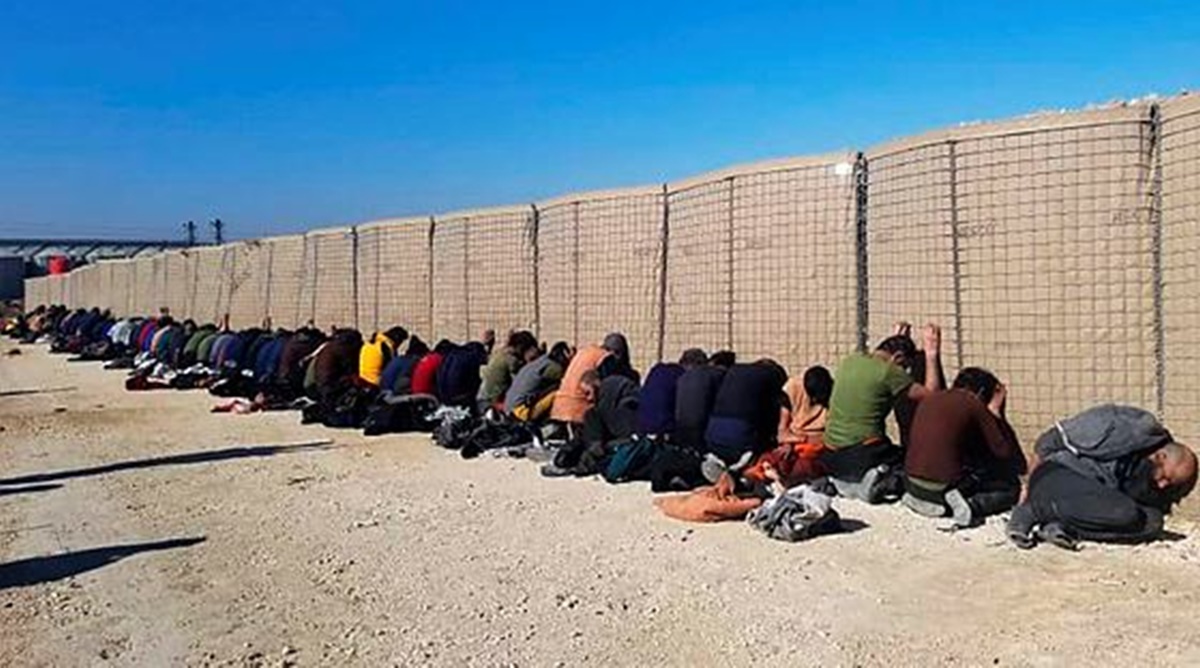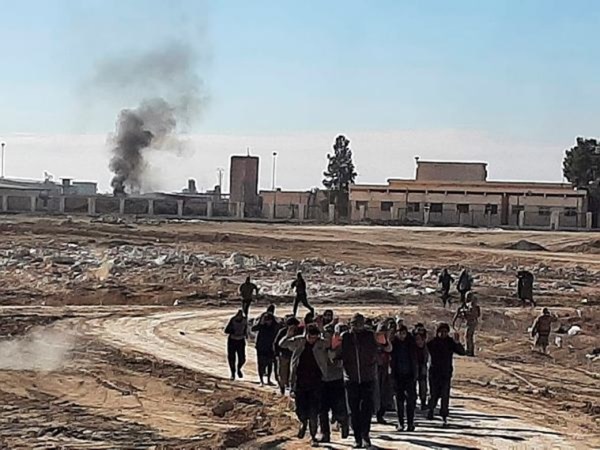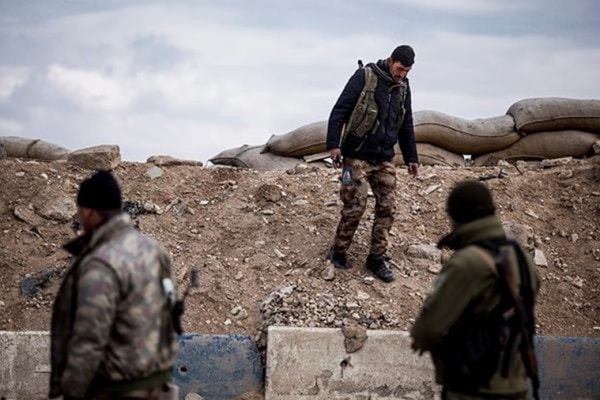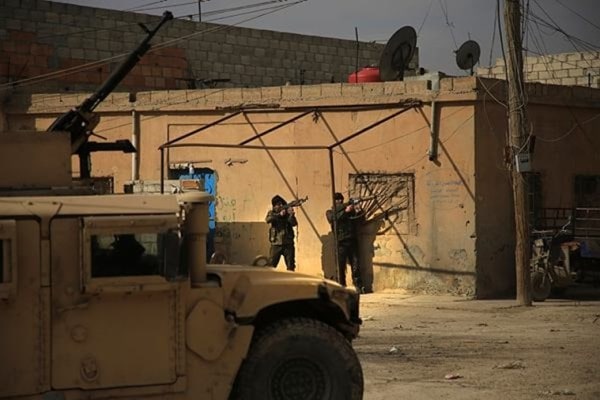 some Islamic State group fighters, who were arrested by the Kurdish-led Syrian Democratic Forces after they attacked Gweiran Prison, in Hassakeh, northeast Syria, Friday, Jan. 21, 2022. IS attacks have been on the rise in recent months in both Iraq and neighboring Syria, where the group once set up a self-styled Islamic caliphate before being defeated by an international coalition. (Kurdish-led Syrian Democratic Forces, via AP)
some Islamic State group fighters, who were arrested by the Kurdish-led Syrian Democratic Forces after they attacked Gweiran Prison, in Hassakeh, northeast Syria, Friday, Jan. 21, 2022. IS attacks have been on the rise in recent months in both Iraq and neighboring Syria, where the group once set up a self-styled Islamic caliphate before being defeated by an international coalition. (Kurdish-led Syrian Democratic Forces, via AP) Written by Jane Arraf, Sangar Khaleel and Eric Schmitt
American ground forces have joined the fight to retake control of a prison in northeast Syria where Islamic State group fighters are holding hundreds of boys hostage, the Pentagon said Monday.
After four days of American airstrikes, the fight has become the biggest known U.S. engagement with the Islamic State group since the fall of its so-called caliphate three years ago.
Hundreds of Islamic State group fighters attacked the makeshift prison in Hasaka, Syria, on Friday in an effort to free their detained comrades in one of the boldest attacks by the group in the region in recent years.
The siege of the prison, which houses about 3,000 suspected ISIS fighters and almost 700 boys, has evolved into a hostage crisis with Islamic State group fighters still holding about one-quarter of the prison and using the boys as human shields.
The makeshift prison has long been an avowed target for a resurgent Islamic State. Housed in a converted school, it is the largest of several prisons in the region holding thousands of fighters detained after the territorial defeat of the Islamic State group in 2019.
 An Syrian Democratic Forces (SDF) spokesman said that about 300 Islamic State group fighters had surrendered but that the Islamic State had threatened to kill the boys if the coalition continued its assault on the prison. (SDF via AP)
An Syrian Democratic Forces (SDF) spokesman said that about 300 Islamic State group fighters had surrendered but that the Islamic State had threatened to kill the boys if the coalition continued its assault on the prison. (SDF via AP) The U.S.-backed force overseeing the prison, the Syrian Democratic Forces, has complained for years that it lacked the ability to operate it securely.
The SDF said that it had recaptured one of the prison’s three buildings in a dawn raid Monday.
An SDF spokesman said that about 300 Islamic State group fighters had surrendered but that the Islamic State had threatened to kill the boys if the coalition continued its assault on the prison.
“We have some reports saying that ISIS is threatening to kill all the minors if we continue attacking them,” the spokesperson, Farhad Shami, said, using an alternative name for the Islamic State group. He estimated that 25% of the complex was still under Islamic State group control.
The Pentagon said that the coalition had moved in armored Bradley Fighting Vehicles to back the SDF forces, indicating for the first time that U.S. ground forces were involved in the fight. A coalition official said the vehicles had been fired at and had returned fire.
“We have provided limited ground support, strategically positioned to assist security in the area,” John Kirby, the Pentagon spokesperson, told reporters in Washington. “For instance, putting Bradley Fighting Vehicles across access points to help block as obstacles.”
 Fighters with the Kurdish-led Syrian Democratic Forces man a checkpoint in Hassakeh, northeast Syria, Monday, Jan. 24, 2022. (AP Photo)
Fighters with the Kurdish-led Syrian Democratic Forces man a checkpoint in Hassakeh, northeast Syria, Monday, Jan. 24, 2022. (AP Photo) The United States has also carried out airstrikes with Apache helicopter gunships over the past four days to try to break the siege, killing an unknown number of prisoners.
The U.S. troops are part of a residual force of the American-led military coalition kept in Syria to assist the SDF in the fight against the Islamic State group and to protect oil installations. There are about 700 U.S. troops in northeast Syria, operating mostly from a base in Hasaka, and another 200 near Syria’s border with Jordan.
Shami said that 30 SDF fighters had been killed in the operation to take back the prison, and that about 200 Islamic State fighters and inmates who joined them in an attempt to escape had been killed in the operation since Friday. It was not clear how many prisoners had escaped.
The inmates include boys as young as 12, including Syrians, Iraqis and about 150 non-Arab foreigners. Some had been transferred to the prison after they were deemed too old to remain in detention camps that held families of Islamic State group suspects.
The siege of the Sinaa prison in Hasaka demonstrated that the Islamic State group still had the ability to mount a coordinated military operation, despite its territorial defeat by the United States and international forces three years ago. At its peak, the jihadi group held territory the size of Britain straddling Iraq and Syria.
 Kurdish-led Syrian Democratic Forces fighters, take their positions at an alley near Gweiran Prison, in Hassakeh, northeast Syria, Sunday, Jan. 23, 2022. (AP/PTI)
Kurdish-led Syrian Democratic Forces fighters, take their positions at an alley near Gweiran Prison, in Hassakeh, northeast Syria, Sunday, Jan. 23, 2022. (AP/PTI) The commander of the Syrian Democratic Forces, Mazlum Kobani, said the Islamic State group had mobilized sleeper cells and used suicide bombers to organize the breakout.
The SDF has repeatedly asked the international coalition for support to build and operate a more secure prison.
Rights activists have demanded that the prisoners be returned to their countries of origin for prosecution or rehabilitation, but most have refused to take them back. They have often compared the prison to the U.S. detention center in Guantánamo Bay, Cuba, as a place where suspects can be warehoused and forgotten.
The State Department said Monday that the siege highlighted the need for international financial support to improve security at the prison.
“It also underscores the urgent need for countries of origin to repatriate, rehabilitate, reintegrate and prosecute, where appropriate, their nationals detained in northeast Syria,” the State Department’s statement said.
- The Indian Express website has been rated GREEN for its credibility and trustworthiness by Newsguard, a global service that rates news sources for their journalistic standards.

